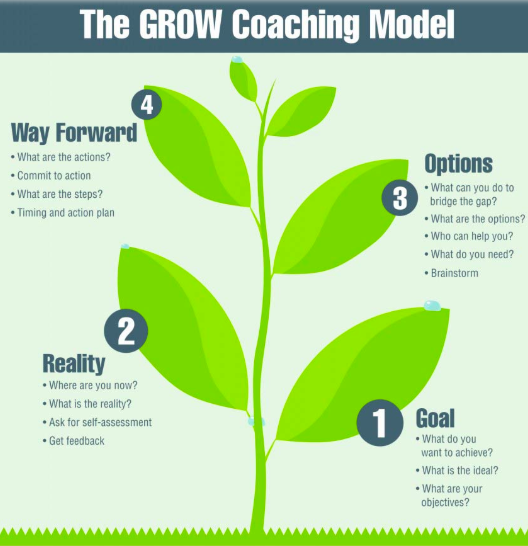
Every coach will need to use a structured coaching model to bring their coachee from where they are currently, to where they want to be. When I first heard about this GROW model, developed by Graham Alexander, Alan Fine and Sir John Whitmore, I was struck by how simple and yet effective it can be.
We start the coaching session with a topic… “What do you want to talk about today?” That sets the stage for the coaching session. I can certainly use this coaching model within my work environment with my staff. I have a staff that has been working with me for 6 years now, and interestingly, I have subconsciously worked through parts of this model with her, even before I ever knew this model existed!
Every year, I will ask her, “What do you want to achieve for yourself this year?” Honestly, as an employer, it is sometimes hard to just listen without putting answers into your employee’s mouth. We might have our own agendas, but I realised that if my dream is not her dream, it’ll be hard to get her to progress and shine. Year after year, she will share about a goal of hers, or how she can improve in a particular area.
She acknowledges that sometimes, her skills falls short of her goal, but with encouragement, support and the opportunities given, she has proven herself over and over again. I am really proud that she has indeed learnt to commit to her dreams and work towards it. Today, she is a multi-talented individual who has achieved so much and continues to work towards self-improvement.
As I learn more and more about coaching, it is less about what or how you do things, but more and more about what you become.
Now that I know about this GROW model, I think I can be a more effective employer and coach to her. It is indeed fulfilling when you can help someone achieve their dreams.
I believe I will be using this GROW model quite frequently when I start coaching. Here’s how the GROW model works.
GOAL
It is important to set clear goals at the start of the coaching session so that you know where you’re headed. The meaning you place towards a goal will drive you forward even more. Some of us are afraid to set goals or dreams in life. Asking open-ended questions will lead them to ponder about the end result that they hope to achieve in life.
1. What is your end outcome for this coaching session?
2. What do you want to change?
3. What would you like to happen with ________?
4. When would you like to achieve your goal?
5. How is this goal linked to your bigger dreams?
REALITY
Once we establish the coachee’s goals, we can then ask questions to evaluate what the current reality is for our coachee. Some people tend to focus on problems and might spend the entire coaching session talking about what stops them from achieving their goals. When discussing about reality, we could possibly unveil other areas of a coachee’s life that points to another challenge and a completely different goal.
1. What is happening now (who, what, when, and how often?)
2. What have you already implemented?
3. What progress has happened so far?
4. What’s stopping you?
5. Where are you now in relation to your goal?
OPTIONS
If a coachee is stuck, we need to reflect back to them their areas of strength that have been revealed in the session. This will help them unlock options to move forward.
1. What could you do differently?
2. What 3 steps could get you towards your goal?
3. What could you do if money was unlimited?
4. What could you do if you knew you could not fail?
5. If anything were possible, what could you do?
WILL / WAY FORWARD
Intentions without actions remain as dreams unfulfilled. The coach will need to guide the coachee towards action, but with a realisation that they need to be accountable for their own progress.
1. Which option are you ready to act upon?
2. How could you start to work towards your goal?
3. When do you plan to reach your goal?
4. What support do you need to get there?
5. How will you overcome your obstacles?
Finally, with every goal achieved, we celebrate! Time to set a new goal, and the process starts all over again.

Photo by Amy Shamblen on Unsplash
Cover image credit: Daniel Öberg on Unsplash
